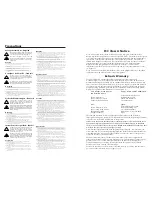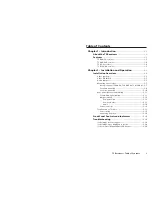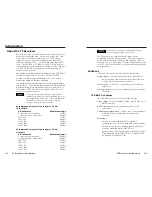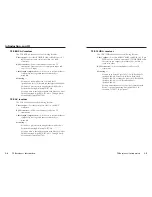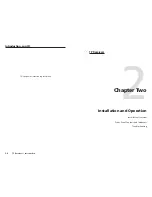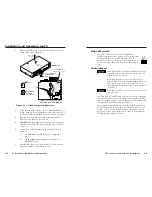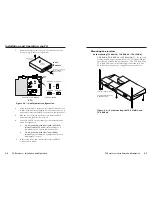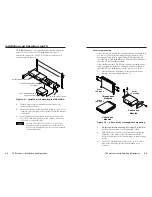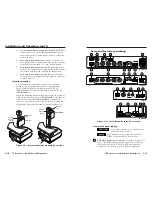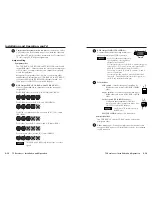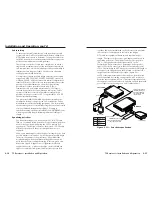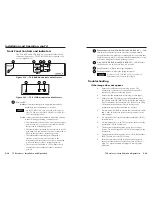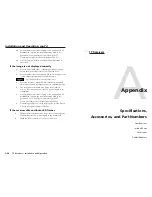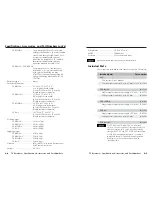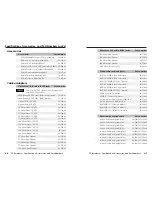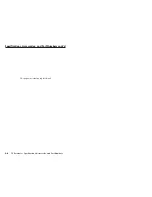
TP Receivers • Installation and Operation
TP Receivers • Installation and Operation
Installation and Operation, cont’d
2-16
Cable testing
To ensure proper cable termination, each transmission cable
system that uses CAT 5e should be tested (Extron’s Skew-Free
UTP cable does not need to be tested). Testing the cable from
the RJ-45 connections at the transmitter and receiver gives the
most accurate indications of cable problems.
There are two varieties of cable runs: simple runs, in which a
single cable is terminated only at the transmitter and receiver,
and complex runs, which can include patch bays and multiple
terminations and lengths of cable. In either case, the entire
cabling system should be tested.
A complete test measures cable length and tests the wire map,
attenuation, NEXT, PSNEXT, ELFEXT, PSELFEXT, return loss,
ACR and PSACR. All of these tests are critical for digital data
transfer. While all of these tests are important indicators of the
quality of the cable termination, the most critical testing
parameters for video transfer are wire map (T-568-A
termination) and pair length measurements. The largest
concern is equalization of skew between cable pairs. Cable
systems of 300 feet or less should exhibit no transmission
problems if they pass at least CAT 5e or preferably CAT 6-D5
channel certification testing.
The Microtest OMNI SCANNER 2 performs comprehensive
certification testing to the proposed CAT 6 standards. Other
manufacturers also make testing equipment. The tests include
advanced diagnostics for troubleshooting the cause and location
of many cable and termination problems. For simple
installation testing, the Microtest MICRO SCANNER PRO tests
wire map and cable length, including individual cable pair
length.
Equalizing pair skew
The manufacturing process for network (CAT 5e) UTP cable
leads to a condition called pair skew. For best results, pair skew
needs to be equalized when using the CAT 5e cable in A/V
applications. The design of Extron’s skew-free A/V UTP cable
minimizes pair skew to the point that equalization is not
required.
Skew exists between pairs when the physical length of one wire
pair is different from another. As the transmission cable length
increases, the amount of skew increases. Skew affects the
displayed image when the differential length between wire
pairs exceeds 2 feet, causing the timing of the red, green, and
blue video signals to appear out of alignment (horizontal
registration errors). A white vertical line on a black field can
appear as individual red, green, and blue lines that are close
together; the signal transmitted on the shortest wire pair leads
the other colors and appears to the left on the display.
UTP cable test equipment measures and reports wire pair
length. The report on the various pair lengths can be used in
equalizing pair skew. The nominal velocity of propagation
(NVP — the speed at which the signal travels on the
transmission line, measured as a percentage of the speed of
light) of TP cable is very close to that of conventional coaxial
cable. The similarity in NVP means that an additional length of
coax equal to the length of pair skew, placed on the receiver’s
output, equalizes the effects of pair skew (figure 2-11).
If UTP cable test measurement cannot be done, pair skew can
still be equalized by viewing a test pattern with a critical eye.
Examine the test pattern for loss of horizontal registration and,
through a process of trial and error, equalize any pair skew with
coax extensions on the red, green, and/or blue outputs.
TP T 15HD A
TP R BNC A
TP T
15HD
A
H-S
HIF
T
BU
FFE
RE
D
CO
MP
UT
ER
INP
UT
AU
DIO
ID PIN 4
ID PIN 11
LO
CA
L M
ON
ITO
R
PC Computer
CAT 5 UTP Cable
Audio
LCD Projector
... THEN insert a four foot
extension cable to equalize
TP skew for red video.
IF cable measurement
indicates that the pair
with wires
1 and 2
is
four feet shorter than
the other pairs...
RG
B
IN
PU
T
RG
B
OU
TP
UT
R
G
B
H/
HV
V
A
AU
DI
O
L
R
B
SOG
C SYNC
PO
W
ER
15
V .
5A
D
C
L
R
Pair
RGB video
1, 2
Red
4, 5
Green
7, 8
Blue
Figure 2-11 — Pair skew equalization
2-17


